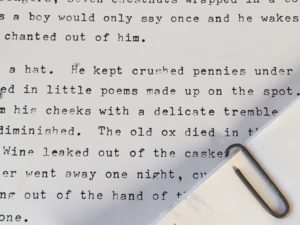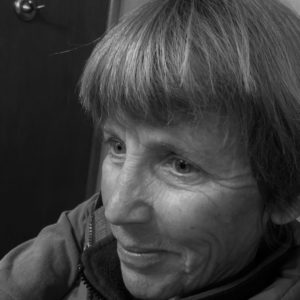 The house has good bones. The morning light falls on walls and sills and floorboards, and on the old kitchen stove. Here is the kitchen table where I used to write. There’s the painted chair my friend Malaga rescued from the corner of Broadway and 92nd Street. For 200 years the house has occupied this overgrown hollow. This used to be my home on Cape Cod and now I’ve come back to empty it so it can become home to someone else.
The house has good bones. The morning light falls on walls and sills and floorboards, and on the old kitchen stove. Here is the kitchen table where I used to write. There’s the painted chair my friend Malaga rescued from the corner of Broadway and 92nd Street. For 200 years the house has occupied this overgrown hollow. This used to be my home on Cape Cod and now I’ve come back to empty it so it can become home to someone else.
There’s a presence here that doesn’t change. Over two centuries the human spirit has seeped into the pores of the wood and plaster, and the spirits breathe through the house and give off the aura of good intention. Outside is a different story. I’ve been gone 17 years and the trees, especially the ailanthus or trees of heaven as they are called, have walked into this hollow and taken over. Like the cup of a hand the clearing here holds and nurtures whatever’s offered, and the ailanthus, lilac, locust and poison ivy offered themselves and were taken in. We can barely breathe. The house gasps for air. Inside is a warm good feeling but outside is oppressive, still, moist, and even at midday whining with mosquitoes.
The objects left behind are memory itself. A box of typewriter ribbons. Sea glass on a shelf. A crumbling rib—young whale? Atlantic porpoise?—which I saw as a magical conduit and nailed to the wall of the upstairs room. Rattan chairs, their striped cushions faded to a soft blur. A message taped to the toilet lid, my handwriting: TOILET MAY RUN. JIGGLE THE HANDLE. It does still run. The jiggling still fixes it.
Windows stick. Boards complain beneath my feet. Where the little tree grew up through the floor every spring there’s now a strip of duct tape. Coves of neglect interrupt the coastline of well-cared-for. Under the kitchen sink, at the back of every drawer—evidence of time and decay. Yet there’s a sense of good cheer here, and in the downpour of last Friday, as the outside quickly became inhospitable, I was aware of the sheltering nature of the house. Windows wide open, no rain coming in. Like a large protective body shielding me and my few possessions. Inside became more than an idea in that storm; it was a place I needed, a reference point on my psychic map. I could count on the house, that’s what I discovered, and it makes me a most grateful guest.
Men have come to cut down the trees. They are using brush-cutters and chainsaws to open up the clearing. The word clearing. Noun and verb form. What we’re doing here and the hollow that holds us—the word for both is the same. Boxes in the attic are pulled out into the dull light of the afternoon. An overwhelming amount of history falls between my hands—old manuscripts bearing more than one novel’s opening lines. Photographs in which I look happier than I remember feeling. A lover’s handmade book of drawings of a goat. My father’s scrawled encouragement to me on a New York Times article on writing. Journals from Burma, Ireland, Croatia, and from the foreign nation of near-marriage. Years of correspondence with a friend—almost daily letters on canary yellow paper, single-spaced scratchings on my Olympia typewriter. And a prize beyond emotional content: deeds to the house dating back to 1874, wrapped in pink paper and arranged incongruously in a shallow box a scarf might come in.
Here are the things I can throw away: journals, photographs, manuscripts and old correspondence. Here are the things I can’t throw away: maps. Topo maps of Cape Cod; maps of Boston, Rome, Rangoon and Ireland’s Beara Peninsula; an old Rand McNally atlas of the world. A map for everywhere I traveled. A map for when I stayed home. A map of the property here, back when the house sat on 14.1 acres. Easier for me to get rid of The Art of Loving than my maps.
How many pounds of words have I taken to the dump today? All those canary yellow pages covered with tattoos of typewriter print. Boxes and boxes (old Red Wing boot boxes) of writing from when I first began my very intentional journey toward being a writer—after the child days of recording everything I felt or noticed in a five-year diary with no lock; after the college days of poetry and creative writing classes with Hugh Ogden and Stephen Minot—when I first discovered that being in love leads to writing, and writing can skate on past any particular love and continue on the energy of the residue. Pages and pages of love and residue with one heft of the arms and hands that created them, into the hopper. Into the crushing machine. Slight catch in the chest, lasting only a homeward mile or two. I remind myself: I do this because I believe in death. This is a way of believing in the death of the body, the death of form. Those crushed words are like cells sloughed off every forty years. Not me—me—not me. They contribute to the illusion of me and take nothing of me as they go. And the weight of them! More weight equals more substance, we believe. That’s how our psyche figures it. These words, as I write them, weigh nothing and may never be committed to paper, may never fall off the screen and accumulate weight, may only ever zip through the air as energy and land fully formed and untouchable.
That’s the entirely new turn this art form has taken: weightlessness, formlessness, truthfully ephemeral. But beware, for with it comes a loss of the sensual—the nubbly texture of paper, the Rorschach splatter of ink, the clatter of keys and the electric urge of the fingers to bear down, to express. With the loss of the sensual comes a world without beauty, a flat irreverent world with no call for art. Here is the kitchen table, worn on the edge where I used to run my hand along it, a dreamy back and forth, a cogitation before the flurry of physical intention that translated thought to paper, plot and character to words with the typewriter’s rattle and ding. The old art form in the old house where I used to live. I say goodbye to both, reluctantly, and move into a younger world.
Margaret Erhart is a writer, teacher, traveler and landlady. Some of her favorite work has been as an artist-in-the-schools in Tuba City, as a firefighter and as a Grand Canyon hiking guide. She is the author of five novels and has published essays in a variety of magazines. To find out more about her work, take a look at www.margareterhart.com.

